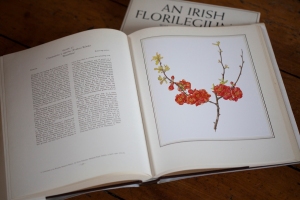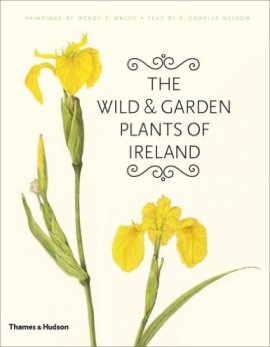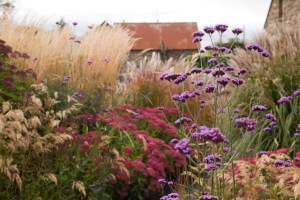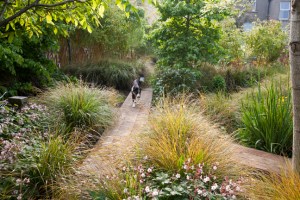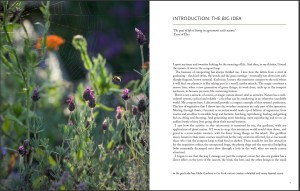Hurrah: we win an award.
November 27, 2015 § 9 Comments
When I was in art college studying woven textiles, I won the Lillias Mitchell award for hand-spinning. I got a nice letter and a small cheque. That was decades ago, and I never won anything after that except for two raffle prizes.
Until yesterday.
Yesterday, my book, The Irish Garden, won the Inspirational Book of the Year award at the Garden Media Guild Awards in London. You could say (and I have, a bit) that they are the BAFTAs (or the Oscars) of the gardening world. My husband, Jonathan Hession, took the photographs, so it is very much our book, not just mine. We worked on it for over four years. It was so all-pervasive that it was almost like having a small person living with us, with all the attendant joys and difficulties.

During this period, our publisher, Frances Lincoln, showed a fair amount of forbearance, especially my editor, Jo Christian, who now runs her own independent publishing house, Pimpernel Press. The book designer Anne Wilson created a thoughtful and beautiful design. If you ever need a garden book designer — she’s the best.
We didn’t go to the awards ceremony, so we learned by email that we’d won. We had a couple of glasses of Prosecco to celebrate. The dog vomited. We went to bed at 2am. It was a grand night.

Here is what the judges said:
“A superbly researched book that reads as wonderfully as it looks. Sumptuous, illustrative photography illustrates copy that takes you by the hand to enjoy a journey through the history, styles, variety, atmosphere and characters of a huge range of valuable Irish Gardens. There is much to admire and inspire in the pages of the book, and its relevance is so important to any gardener’s library. Congratulations to the husband and wife writer/photographer team Jane Powers and Jonathan Hession, their passion for the gardens in the area they live is alive and obvious in every page.”
Finalists
Victoria Clarke The Gardener’s Garden
Heidi Howcroft & Marianne Majerus Garden Design: A Book of Ideas
Carol Klein Making a Garden: Successful gardening by nature’s rules
James Wong Grow For Flavour
Wendy Walsh: an appreciation
March 22, 2014 § 13 Comments
On the night of Monday, March 3rd 2014, Ireland’s most respected botanical artist died, a month before her 99th birthday. Wendy Walsh (née Storey) was born in Bowness-on-Windermere in Cumbria, but she came to live here in 1958 when her husband, Lt. Col. John Walsh, originally from Edgeworthstown in Co Longford, retired from the British army.
It was not until Wendy Walsh was in her sixties that her work became widely known. In 1978 her paintings of wildflowers were reproduced on four postage stamps, and for the following six years she was commissioned annually to produce stamps on the theme of Irish flora and fauna. In 1983, she collaborated with Dr Charles Nelson and Ruth Isabel Ross on the first volume of An Irish Florilegium: Wild and Garden Plants of Ireland, a sumptuous publication with 48 hand-tipped colour plates. Her name was suddenly everywhere, and the book was found in all the best drawing rooms. Today, the scarce first edition is offered for between €600 and €1250 by rare book dealers. The second volume followed in 1988.
Wendy’s paintings are keenly observed plant studies, with each detail carefully and faithfully rendered. They exactly capture the vulnerable softness of a petal, the beige brittleness of an autumn flower stalk, the joyful freshness of a spring bud, the angular kink in a year-old twig. Her colour matches are flawless and her composition elegant. In her best works, her subjects inhabit the page with the same kind of poise and presence that a great dancer manifests on stage.
The paintings are all the more remarkable because Wendy Walsh was that rare thing, a self-taught artist in a discipline that requires a precise knowledge of a science: in this case, botany. She was brought up, as she told me a few years ago, “in a curious old age” with a “mother who hated school and wouldn’t let any of her girls go to school.” She was taught by an “indifferent governess” until she was 14, and had no further education after that. Yet, she had an analytical and curious mind, consuming books and — as a teenager — keeping an illustrated wildlife diary.
Her mother named her Wendy Felicité after a favourite cocker spaniel and a French rose. She was gracious about the quirky origins of her name, and believed that it shaped her career as a painter of animals and plants. In the 1930s, she undertook commissions to paint dogs. She rode horses and hunted, and enjoyed herself immensely. “The 1930s were blissful times, no money, but lots of fun!”
During the Second World War she worked as a VAD (Voluntary Aid Detachment), a voluntary field nurse, and met a man whose horsemanship made him stand out from the many other officers. She married John Walsh in 1941, following him from camp to camp — moving 13 times in a year — until he was shipped out with the Eighth Army to north Africa. His army work during and after the war saw him travel extensively, including to the United States, India, Japan and Singapore. Sometimes Wendy and the growing family (three children eventually) were in tow, sometimes not. She told me: “That’s what the army’s like. We were always being separated and starting again.”
Eventually they settled back in Ireland, in Lusk, while John worked as the agent for Trinity College in Dublin, managing the campus. In 1999, after 40 years in north county Dublin, they moved to the stable-yard of Burtown House in Athy, Co Kildare, the home of their daughter, Lesley Fennell, a portrait painter.
Throughout her life, Wendy drew and painted whenever she had time, and over the years completed hundreds of commissions. She won numerous awards, including gold medals from the Royal Horticultural Society and the Alpine Garden Society. In 1996 Trinity College Dublin conferred an honorary DLitt on her, which, she said: “made me laugh, and delighted me so much. It struck me as funny that someone who had never been to school could call themselves doctor.”
Wendy worked on over a dozen books, almost all of which were close collaborations with Charles Nelson, the former taxonomist at the National Botanic Gardens. Their working relationship, he says, was “a very amicable partnership”.
She was a good teacher, too, and continued to take students into her nineties. One former student recalls how she gave careful attention to each class participant. When a piece was so wrong that it was impossible to correct, she would say kindly, but pointedly: “That is rather a mistake.”
Many of those in the newly formed Irish Society of Botanical Artists have been inspired by this talented, generous and modest woman. It is fitting that on the morning of the society’s foundation on March 1st, just two days before her death, she was nominated its first member.
Wendy Walsh: April 9th 1915 – March 3rd 2014
The Wild and Garden Plants of Ireland, paintings by Wendy F. Walsh, with text by E. Charles Nelson, was published by Thames & Hudson in 2009. All the 99 illustrations from the 2-volume Irish Florilegium are gathered into this book: a perfect introduction to the work of Wendy Walsh.
This blog post is an a version of my column, which appeared in the Sunday Times on March 16th 2014
A few good books
December 9, 2013 § 4 Comments
I’ve been up to my oxters in garden-related books for the past couple of weeks in order to bring you my pick of the crop for 2013. First though, I have a plea. I have noticed that an increasing number of books now contain no index. Negotiating a book without an index is like navigating without a compass, GPS or other aid. It takes away the fun and adds a heap of frustration. My plea to publishers is this: don’t lose the index for the sake of a few quid. If non-fiction books are to compete with the internet, they must hold on tight to their indexes.
 One book that I can’t put down is Seeing Flowers, with photography by Robert Llewellyn and text by Teri Dunn Chace (Timber Press, £20). Its 175 exquisite macro photographs of flowers are completely addictive. I keep returning again and again to sneak another look, and to read Chace’s informative text. Llewellyn uses “focus stacking”, where multiple shots of a subject are taken at varying focus points and then melded together in a computer application. The results are luminous, delicate portraits with every last hair and pollen grain in focus.
One book that I can’t put down is Seeing Flowers, with photography by Robert Llewellyn and text by Teri Dunn Chace (Timber Press, £20). Its 175 exquisite macro photographs of flowers are completely addictive. I keep returning again and again to sneak another look, and to read Chace’s informative text. Llewellyn uses “focus stacking”, where multiple shots of a subject are taken at varying focus points and then melded together in a computer application. The results are luminous, delicate portraits with every last hair and pollen grain in focus.
There is more excellent photography, of the luscious kind, by Andrew Lawson, Jane Sebire and Rachel Warne in The New English Garden, by Tim Richardson (Frances Lincoln, £40). It features 25 gardens that have been created or re-created during this century. Among their makers are some of today’s most important designers, including Tom Stuart-Smith, Piet Oudolf, Christopher Bradley-Hole and Arabella Lennox-Boyd (who has recently redesigned the landscape at Airfield in Dundrum, Dublin). The book is an important record of a new golden age in British garden design. Among the well-known horticultural hot spots in its pages are Christopher Lloyd’s Great Dixter, James Hitchmough’s and Nigel Dunnett’s Olympic Park, and the over-egged pudding that is the Prince of Wales’s Highgrove.
 Tim Richardson has also edited Of Rhubarb and Roses: The Telegraph Book of the Garden (Aurum, £25). This is a compendium of articles from the newspaper for the pin-striped elite, which has always had excellent horticultural coverage. The book’s contributions range from 1935 to the present day and come from Vita Sackville-West, Constance Spry, Mary Keen, Fred Whitsey, Beth Chatto, Dan Pearson, and many others. Also included are garden-related letters to the editor and news items. Not included is an index, but the publisher has left 20 blank pages at the end, so you could write your own, I suppose.
Tim Richardson has also edited Of Rhubarb and Roses: The Telegraph Book of the Garden (Aurum, £25). This is a compendium of articles from the newspaper for the pin-striped elite, which has always had excellent horticultural coverage. The book’s contributions range from 1935 to the present day and come from Vita Sackville-West, Constance Spry, Mary Keen, Fred Whitsey, Beth Chatto, Dan Pearson, and many others. Also included are garden-related letters to the editor and news items. Not included is an index, but the publisher has left 20 blank pages at the end, so you could write your own, I suppose.
 Planting: A New Perspective, by Piet Oudolf and Noel Kingsbury (Timber Press, £30) is an essential guide for those interested in the new perennial planting style. The naturalistic look may seem effortless, but it is not easy to pull off successfully. So often, one year’s harmonious scheme becomes next year’s brawl, as tough plants take over, delicate ones die out, and weeds creep in when no-one is looking. This book equips the reader with the information needed for crowd control in perennial plantings, explaining the ecology, behaviour and mechanics of the most suitable varieties. There are extracts from some of Oudolf’s plans, including snippets from his famous New York High Line planting scheme.
Planting: A New Perspective, by Piet Oudolf and Noel Kingsbury (Timber Press, £30) is an essential guide for those interested in the new perennial planting style. The naturalistic look may seem effortless, but it is not easy to pull off successfully. So often, one year’s harmonious scheme becomes next year’s brawl, as tough plants take over, delicate ones die out, and weeds creep in when no-one is looking. This book equips the reader with the information needed for crowd control in perennial plantings, explaining the ecology, behaviour and mechanics of the most suitable varieties. There are extracts from some of Oudolf’s plans, including snippets from his famous New York High Line planting scheme.
 For serious planting designers and students, a useful companion volume to the above is Piet Oudolf’s and Henk Gerritsen’s Dream Plants for the Natural Garden (Frances Lincoln, £20). First published in 1999 and reissued in paperback this year, it is a directory of 1,200 plants suitable for naturalistic gardens.
For serious planting designers and students, a useful companion volume to the above is Piet Oudolf’s and Henk Gerritsen’s Dream Plants for the Natural Garden (Frances Lincoln, £20). First published in 1999 and reissued in paperback this year, it is a directory of 1,200 plants suitable for naturalistic gardens.
 Of course, not everyone wants the space outside their door crammed with uninhibited perennials. It is a style that does not fit all gardens. For those searching for the right mood and structure for their patch, I can recommend The Royal Horticultural Society Encyclopedia of Garden Design (Dorling Kindersley, £25), edited by Chris Young. It is a complete guide to creating a garden, from conceiving and drawing a layout to laying paths, opening vistas and using plants for various effects.
Of course, not everyone wants the space outside their door crammed with uninhibited perennials. It is a style that does not fit all gardens. For those searching for the right mood and structure for their patch, I can recommend The Royal Horticultural Society Encyclopedia of Garden Design (Dorling Kindersley, £25), edited by Chris Young. It is a complete guide to creating a garden, from conceiving and drawing a layout to laying paths, opening vistas and using plants for various effects.
 I’ve also been enjoying Aubrey Fennell’s Heritage Trees of Ireland (The Collins Press, Eur 29.99), which pays homage to over a hundred of this island’s tallest, fattest, oldest, holiest, boldest and otherwise remarkable trees. Our moist and mild climate allows us to grow a greater diversity of trees than most places in the world. The pages of this book demonstrate it, depicting eucalyptus from Australia, redwoods from California, monkey puzzles from Chile, date palms from the Canaries, and a virtual woodland of other species.
I’ve also been enjoying Aubrey Fennell’s Heritage Trees of Ireland (The Collins Press, Eur 29.99), which pays homage to over a hundred of this island’s tallest, fattest, oldest, holiest, boldest and otherwise remarkable trees. Our moist and mild climate allows us to grow a greater diversity of trees than most places in the world. The pages of this book demonstrate it, depicting eucalyptus from Australia, redwoods from California, monkey puzzles from Chile, date palms from the Canaries, and a virtual woodland of other species.
 Our Once and Future Planet, by Paddy Woodworth (University of Chicago Press, book: $35, e-book: $21; kennys.ie: €23.32) deals with restoration ecology, a subject that savvy gardeners should be aware of. Irish-harvested peat-based compost, for example, has helped turn our bogs to sterile tracts. Imagine if they were restored? Woodworth tackles this subject in one of his chapters, while Irish woodlands are the subject of another.
Our Once and Future Planet, by Paddy Woodworth (University of Chicago Press, book: $35, e-book: $21; kennys.ie: €23.32) deals with restoration ecology, a subject that savvy gardeners should be aware of. Irish-harvested peat-based compost, for example, has helped turn our bogs to sterile tracts. Imagine if they were restored? Woodworth tackles this subject in one of his chapters, while Irish woodlands are the subject of another.
Other books that I have enjoyed this year, and have already written about, include Kate Bradbury’s The Wildlife Gardener: Creating a Haven for Birds, Bees and Butterflies (Kyle Books, £14.99), which Alan Titchmarsh rightly calls a “joyous book”, and Alex Mitchell’s The Rurbanite: Living in the Country without Leaving the City (Kyle Books, £16.99), a handbook for townies who yearn for the rural life while still holding onto their urban benefits.
An edited version of the above appeared in my weekly column in The Sunday Times on December 1st 2013
Queen of the Road — and Vegetables too
July 9, 2012 § 7 Comments
It is August 1976, and an old Mercedes van with a small caravan in tow sets off from a farm in Suffolk. Its passengers are a couple and their two children. The cargo spread among the two vehicles includes all the usual camping paraphernalia as well as bicycles, a table, chairs, a telescope, school books, and a small kitchen’s worth of pots, pans, spices and other staples. A gang of teddies, dolls, knitted animals and sundry other gregarious characters crowd the windows, catching a last glance at the East Anglia landscape. Behind them, lumpy black plastic sacks of clothing are piled high. Shelves of reference books, empty biscuit tins and a typewriter complete the inventory. Out on the road, the caravan’s momentum gradually swings open the unsecured doors of the cupboards, dumping their contents onto the jumble of possessions.
Thus started a year-long road trip that garden writer Joy Larkcom and her family made around Europe collecting old and interesting seed varieties (hence the biscuit tins), and gathering intelligence both on traditional cultivation methods and commercial growing practices. The “Grand Vegetable Tour”, as they called it, took place at a time before technology made travelling the constantly-connected and cushy business that it is today.
Communications, accessing money and finding running water were major ordeals. Despite this, Joy — sometimes in shorts and T-shirt, sometimes in scarf and mittens — would set up her typewriter and little table next to the van almost daily, and tap out hard-won notes and articles. Husband Don Pollard, meanwhile, was kept busy fixing the vehicles, schooling the children and coaxing meals (including birthday cakes) out of the caravan’s cooker.
It is thanks to the efforts of this raggle-taggle troupe, staying at camp sites and in farmers’ fields, that British seed companies began to offer vegetable varieties and mixed-leaf salads similar to those found on the continent, and that gardeners became familiar with European methods such as “cut-and-come-again” harvesting and polytunnel growing. In short, Joy’s research and seed collections acted as a catalyst for change in vegetable gardens throughout Britain and Ireland.
In the 1980s, while researching oriental vegetables, she went (sans famille) to China, Japan and Taiwan, and to Asian communities in the United States and Canada. Later excursions took her to vegetable patches, seed companies, markets and trial grounds in many countries. For four decades, she has been a one-woman research institute, collecting seed, making notes and taking pictures wherever she goes, whether it is a Cuban agriponico or a Dublin garden.
Her articles, published in trade periodicals and in magazines for home gardeners, are meticulous, rich in detail and beautifully written. They take a single subject and examine it from every angle. They are virtuoso performances on artichokes, on peas, on pumpkins, on mulching, on the correct spacing of vegetables for greatest productivity, on how to grow mammoth onions, and even on how to achieve champion giant gooseberries. They cover everything to do with the edible garden, and often introduce new ideas and crop varieties.
Joy, now 76, has won many prestigious awards (including the Royal Horticultural Society’s Veitch Memorial Medal) and has published many books. Ten years ago, at a time in their lives when most people are winding down, she and Don moved to a farmhouse near Clonakilty, in west Cork, and started a new garden from scratch. “It was just brilliant almost from the start,”, she tells me, “the sheer beauty of this place — and to hear the sea!”
The couple approached the plot, on a fiercely windswept slope, with the same dauntless enthusiasm that fuelled their year on the road in Europe. “The challenges of starting to garden here were so absorbing. It was a blank sheet, and it was just a lovely experience altogether.” The garden, an intensive patch filled with fruit, vegetables and ornamentals, is entirely organic. Joy, who was never keen on using chemicals, ceased abruptly over forty years ago. While spraying her apples with a particularly nasty tar oil wash, she discovered baby Brendan, caught in the crossfire, covered in great globs of tar.
Although the move to Ireland was supposed to mark the start of her retirement, the woman who is widely known as the Vegetable Queen is still working as hard as ever. She has just published a book, Just Vegetating (Frances Lincoln, £18.99), based on a collection of around a hundred articles written over four decades. Interspersed with photographs, diary pages and other intriguing snippets, they are linked together with a charming and extensive commentary. The book is so warm and appealing that it gives you the feeling of spending an evening with a wise and good friend, with a box of old photos, clippings and other memorabilia.
Although it is still early in the season, I’m pretty sure that this is my book of the year.
An edited version of this article appeared in my weekly column in the Sunday Times
Going forth and scaling new horizons
October 15, 2011 § 21 Comments
This week, my own monument to the past came down. My office had had shelves and shelves of Irish Times newspapers and magazines — each of which contained my gardening columns and other articles.
In the 15 years that I was the paper’s gardening correspondent, and in the preceding two years where I regularly wrote about gardens, I rarely seemed to find the time to cut out my clippings and file them away. I’d have bursts of archiving on quiet days, but the mounds of paper continued to expand, hopping down onto the floor under the bookshelves, and depriving the dogs of their favourite bolthole during thunderstorms and fireworks explosions. In the days since I wrote my final column, which you can read here, I’ve been snipping and clipping, and working my way back from the latter end of 2011 to the beginning of 1995.
I have been rolling through time at the rate of about one year for every two hours of paper cutting and filing. Although I’ve written over seven hundred gardening columns, and hundreds of other pieces, distinct memories come floating up from many of the snippets of newsprint. An interview with the late and marvellously haughty Ambrose Congreve summons a vision of his rakishly red socks, echoed by the faded crimson of Burke’s Peerage close at hand; a piece on trees recalls the absurdity of sitting at a boardroom table while executives from a semi-state organisation briefed me on what they thought should go into the article; a column about a garden in Wexford brings back the day that started badly with a missed train and a pain in my belly, but that ended with my making a particularly special friend.
Working for a newspaper, even when you’re a garden writer, is all about deadlines, and fitting into a monstrously huge and complex machine. Everyone is on a schedule. So the perky Christmas gift article from 1998 was written while our old dog lay fatally injured, waiting for the vet to come and end his life; and a lively piece on Airfield Garden was finished off while I dealt with the news that my father had been found dead on his kitchen floor four thousand miles away. In the last few days, the rapid and continual procession of memories has nearly overwhelmed me.
But there were many things that made me laugh too. Sometimes subeditors (who work under huge pressure) would have to compose headlines without seeing the photo that accompanied the writing. So, one column featured a portrait of one of Ireland’s most self-important gardeners with the headline “Our plump country cousins” (which was actually a quote about plants lifted from the text), and another (also extracting a fragment about plants) shouted “A home for the ugly duckling” under the picture of a formidable lady gardener. She, I’m glad to say, was a good sport about this newspaperistic misfortune. Headline-writing is often like calligraphy, quick and instinctual: “Hosta la vista, baby”, “Sow what?”, “Swards at the ready” and so on. Some headlines suggest themselves automatically, and have muscled into my 15 years of columns more than once, “Scaling new heights”, for example — usually applied to climbing plants.
A photo that I took of the dog above when she was a puppy, by the way, provided one of the magazine’s most popular covers. Lily became a pin-up girl all over Ireland, and also helped the Irish Times win a printing award in 2005. Our printers put “her” cover at the top of the pile, as they knew it would catch the judges’ attention.
I was sorry to give up my gardening column, but now I’m a little relieved too. Gardening used to be something I did to free my soul and level my mind, but when I had to deliver copy every week, my relationship with it changed. I found it hard to set foot outside without feeling I should be taking photos, writing notes, or working out a better way of explaining something. I was seeing my garden at second hand: through the camera lens, or in chunks of 850 or 1200 words. And then, there was the curse of Ireland’s changeable weather. Because copy is written days (and sometimes weeks) in advance I would find myself praying that a horrible drought or fierce frost would continue so that my column would not be out of date when it eventually appeared.
All this may sound as if I’ve given up writing about gardens. But, no, I am working flat out on my second book — which will be published in 2013 (you can read about my first book here and here). And, as before, I’ll be popping up in Irish and British publications. I’ll also be here, on One Bean Row, so I hope you’ll drop in often — or better still, subscribe by email (at the top right corner of the home page) so you never miss a post.
It’s a book!
March 24, 2011 § 15 Comments
My late father, J.F. Powers, was a writer of note in the United States. His first novel, Morte D’Urban, won the National Book Award in 1963. There was some pretty heavyweight competition. His output was small and choice: two novels and three books of short stories. His last book took 22 years to write. I hate to think of the excuses he fed to his agent and publishers, or the guilt that he must have felt after a long day at the office deciding whether to plump for a colon or a dash.
Well, I’ve just written a book too. It took me a little over two years — a mere sprint compared to my father’s marathon. I took all the photos, except for six that my husband Jonathan Hession shot, and one (of my late mother) that my sister Katherine provided.
The book, The Living Garden, is published by Frances Lincoln — my dream publishers. When I started writing about gardening sixteen years ago, I used to look at the beautiful books produced by this independent London house, and imagine my name on the cover and spine of something published by them. So, I was delighted (and more than a little terrified) when I was actually asked by them to submit an idea for a book.
And, a month or two ago, when I finally got my hands on a single, precious advance copy, I put it on the shelf between Beth Chatto’s and Helen Dillon’s books (two of my favourite garden writers), just to see what it looked like. It looked delightful. But I took it down fairly quickly, as it seemed an impertinence to let it linger next to these two great gardening women. (It never even occurred to me to put it next to my father’s books. That would have been far too bumptious.)
If you feel like buying the book, there are links on this page to Amazon (but do try your local bookshop first).
You can read the introduction by clicking on the thumbnails here.
And finally if you want to meet me, I’ll be doing some book signings:
Newbridge Silverware, Newbridge, Co Kildare: 3pm, Friday April 1st.
Brown Thomas, Grafton Street, Dublin 2: 2pm, Saturday April 16th 2011
Launch of the West Cork Garden Trail, Glebe Gardens, Baltimore, West Cork: 11 am, June 11th 2011


